
The wings of two birds that lived among the dinosaurs have been discovered in top condition in Myanmar (Burma). Described in the journal Nature Communications, the tiny wings have been perfectly preserved in amber, after their owners—a brace of baby birds exploring their habitat—became fatally stuck in the ultra-sticky sap of a tropical tree some 99 million years ago.
Researchers believe that the remains came from enantiornithine birds, a big grouping of avialans that lived in the Cretaceous Period and died out alongside the dinosaurs in a mass extinction event about 65 million years ago.
Such is the fine detail of the discovery, that scientists believe the wings could help them unlock details about the evolutionary enigma of exactly how birds evolved from dinosaurs. Visible on the preserved wings are sharp little claws, which would have allowed the juvenile birds to climb around in the trees, a pursuit that likely led to this curious pair’s demise.
‘The fact that the tiny birds were clambering about in the trees suggests that they had advanced development, meaning they were ready for action as soon as they hatched,’ says the study’s lead author, Dr Xing Lida, from the China University of Geosciences.
‘These birds did not hang about in the nest waiting to be fed, but set off looking for food, and sadly died perhaps because of their small size and lack of experience. Isolated feathers in other amber samples show that adult birds might have avoided the sticky sap, or pulled themselves free.’
Dr Lida and an international team of researchers have employed advanced X-ray scanning techniques to examine the structure and arrangement of the bones and feathers.

‘These are showcase specimens and some of the most surprising fossils I’ve seen in a long time,’ Edinburgh University vertebrate palaeontologist Dr Steve Brusatte told the BBC, describing the find as ‘spectacular’.
‘We’ve known for a few decades that many dinosaurs had feathers, but most of our fossils are impressions of feathers on crushed limestone slabs… Three dimensional preservation in amber provides a whole new perspective and these fossils make it clear that very primitive birds living alongside the dinosaurs had wings and feather arrangements very similar to today’s birds.’
Professor Mike Benton from the University of Bristol, co-author of the study, was equally excited by the discovery. ‘The individual feathers show every filament and whisker, whether they are flight feathers or down feathers,’ he enthused. ‘There are even traces of colour-spots and stripes.’
